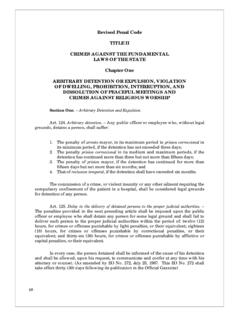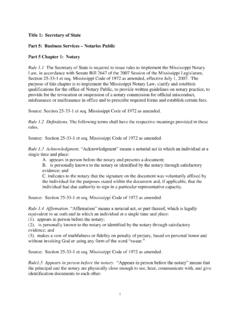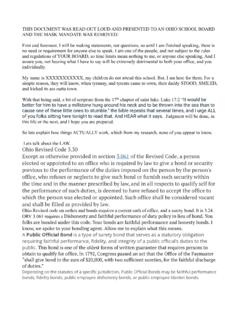Transcription of Misconduct in public office - GOV.UK
1 Misconduct in public officeHC 1027 Law Com No 397LC 397 Misconduct in public office Presented to Parliament pursuant to section 3(2) of the Law Commissions Act 1965 Ordered by the House of Commons to be printed on 3 December 2020 HC 1027 I Crown copyright 2020 This publication is licensed under the terms of the Open Government Licence except where otherwise stated. To view this licence, visit Where we have identified any third party copyright information you will need to obtain permission from the copyright holders concerned. This publication is available at Any enquiries regarding this publication should be sent to us at ISBN 978-1-5286-2279-0 CCS1120583574 12/20 Printed on paper containing 75% recycled fibre content minimum Printed in the UK by the Williams Lea Group on behalf of the Controller of Her Majesty s Stationery office ii The Law Commission The Law Commission was set up by the Law Commissions Act 1965 for the purpose of promoting the reform of the law.
2 The Law Commissioners are: The Right Honourable Lord Justice Green, Chairman Professor Sarah Green Professor Nicholas Hopkins Professor Penney Lewis Nicholas Paines QC The Chief Executive of the Law Commission is Phil Golding. The Law Commission is located at 1st Floor, Tower, 52 Queen Anne's Gate, London SW1H 9AG. The terms of this Report were agreed on 6 November 2020. The text of this Report is available on the Law Commission's website at iii Contents Page CHAPTER 1: INTRODUCTION 1 Background to the project 1 The structure of this report 10 Acknowledgments 11 CHAPTER 2: HISTORY AND CURRENT LAW 12 Introduction 12 History of the offence of Misconduct in public office 12 Current law 20 Other relevant laws 27 CHAPTER 3: THE CASE FOR REFORM 31 Introduction 31 Key problems with the current offence 31 Abolition without replacement? 39 Our proposed model of reform 50 CHAPTER 4: A DEFINITION OF public office HOLDER 52 Introduction 52 Current law 53 Why we need a clear definition of public office 55 Comparative approaches in other jurisdictions 55 Policy objectives for a new definition 60 Our provisional proposals and consultees responses 60 Our conclusions and recommendations 62 CHAPTER 5: CORRUPTION in public office 74 Introduction 74 Current law and practice 74 Consultation paper proposals and responses 76 iv 80 82 92 99 103 Reflections on concerns raised in consultations regarding serious impropriety Proposal for a new offence of corruption in public office A public interest defence Sexual Misconduct and the corruption offence Labelling the replacement offence Repeal of section 26 of t he Criminal Justice and Courts Act 2015 104 CHAPTER 6.
3 BREACH OF DUTY in public office 106 Introduction 106 Current law and practice 106 Consultation paper proposals and responses 107 Reflections following consultation responses 111 Recommended breach of duty offence 112 CHAPTER 7: PROCEDURE, SCOPE AND SENTENCING OF CORRUPTION AND BREACH OF DUTY OFFENCES 126 Introduction 126 Mode of trial 126 Accessorial liability 130 Inchoate liability: encouraging or assisting, conspiracy and attempt 132 Intoxication 137 Corporate liability 138 Jurisdictional issues 140 Welsh devolution implications 144 Maximum penalties 144 CHAPTER 8: PROSECUTORIAL GUIDANCE AND CONSENT TO PROSECUTE 147 Introduction 147 Prosecutorial discretion and guidance 147 Consent to prosecute 154 CHAPTER 9: SEXUAL Misconduct AND SEXUAL OFFENCES 159 Introduction 159 Forms of sexual Misconduct prosecuted under the current offence 159 What we said in our consultation paper 162 v Consultation responses 164 Conclusions following consultation responses 168 CHAPTER 10: RECOMMENDATIONS 171 APPENDIX 1: LIST OF RESPONSES TO CONSULTATION PAPER 178 1 Misconduct in public office To the Right Honourable Robert Buckland QC MP, Lord Chancellor and Secretary of State for Justice Chapter 1.
4 Introduction BACKGROUND TO THE PROJECT The criminal offence of Misconduct in public office may be committed by a public office holder, who, while acting in the role of the public office , wilfully neglects to perform his or her duty or wilfully misconducts him or herself, to such a degree as to amount to an abuse of the public s trust in that It is a common law offence, dating back hundreds of years, and therefore its terms have been established through case law, rather than in legislation. Misconduct in public office is one of the most notoriously difficult offences to define in England and Wales. While this has always been an issue, the increased usage of the offence by police and prosecutors in recent decades has exacerbated the problem. In the past two decades, a substantial body of case law has refined, and in some cases shifted, the terms of the offence. The offence has also begun to be used in relatively novel contexts, such as the prosecution as secondary parties of journalists who have encouraged public office holders to leak confidential information.
5 This has generated significant controversy. In recent years there have also been high profile inquiries into alleged Misconduct by public office holders such as the various inquiries into the Hillsborough disaster, and the current Undercover Policing In this context, questions have been raised as to how well-equipped the common law offence is to deal with modern forms of Misconduct . In 2010, a report by the House of Commons Committee on the Issue of Privilege stated: In our view, the current law on Misconduct in public office remains unsatisfactory, not least because it is punishable with up to a life sentence. We recommend that the 1 AG s Reference (No 3 of 2003) [2004] EWCA Crim 868; [2005] QB 73. 2 See Undercover Policing Inquiry, About the Inquiry (17 July 2019), available at 2 Law Commission re-visit its 1997 recommendation that Misconduct in public office be made a statutory offence, in the light of developments of the past dozen In the 2011 case of DL, Lord Justice Leveson stated that consideration of the offence by the Law Commission would be of value.
6 4 These views, together with consultation responses to our Eleventh Program, led us to include a review of the common law offence of Misconduct in public office in our Eleventh Programme of Law We did not expect this to be a simple task, and it has not proved to be so. As we note below, there have been several previous considerations of reform of the offence, none of which have ultimately led to any substantive change. In this report we do recommend substantive reform of the offence, through the repeal of the common law, and replacement with two more precise and targeted statutory offences. This follows an extensive process of consultation, and a thorough consideration of the complex legal and policy issues the offence entails. This report describes the process of our review and details our reform recommendations. We consider that our recommendations represent an improvement on the current common law offence, and if implemented, they should result in a clearer articulation of the scope and application of the offence.
7 As with many law reform projects, it has proved impossible to reach universal consensus on the exact form of the office , and differences of view exist over the extent to which certain forms of Misconduct should be a matter for the criminal law. We have subjected the recommendations we make in this report to careful scrutiny by expert consultees and interested bodies including the Crown Prosecution Service, the Director of public Prosecutions, the judges at the Central Criminal Court and Sir Brian Leveson (when President of the Queen s Bench Division of the High Court). Our recommendations seek to strike a balance between punishing and deterring the most serious forms of Misconduct by public office holders, while leaving space for civil and disciplinary penalties, and other, less serious offences, in cases that do not warrant such serious criminal sanction. 3 Police Searches on the Parliamentary Estate, First Report of the Committee on Issue of Privilege (2009-10) HC 62 at [57].
8 4 [2011] EWCA Crim 1259; [2011] 2 Cr App R 14 at [21]. 5 Eleventh Programme of Law Reform (2011) Law Com No 330 at paras to The Law Commission is required to receive and consider proposals for law reform and to prepare and submit to the Lord Chancellor, from time to time, programmes for the examination of different branches of the law with a view to reform. The terms of the Eleventh Programme of Law Reform were agreed on 27 May 2011. 3 History of the offence and calls for reform The common law offence of Misconduct in public office has existed for hundreds of The most well-known historical statement of the offence was made in 1783, by Chief Justice Mansfield in the case of In describing the offence in his judgment, Chief Justice Mansfield stated: Here there are two principles applicable: first that a man accepting an office of trust concerning the public , especially if attended with profit, is answerable criminally to the king for misbehaviour in his office : this is true, by whomever and whatever way the officer is appointed [.]
9 ] Secondly, where there is a breach of trust, fraud or imposition, in a matter concerning the public , though as between individuals it would only be actionable, yet as between the King and the subject it is indictable. That such should be the rule is essential to the existence of the country. The offence fell largely into disuse between the late 18th century and the beginning of the 21st century, and there were only occasional reported cases. These included Borron8 in the 19th century and Llewellyn-Jones,9 Dytham,10 and Bowden11 in the 20th century. We consider these cases, and the historical development of the offence more generally in Chapter 2. In parallel with the criminal offence, there exists a tort of misfeasance in public office , early manifestations of which date back to the 18th While not directly the subject of this review, we also briefly outline the history of the tort in Chapter 2.
10 Despite the relatively infrequent use of the criminal offence in the 20th century, there were a number of proposals to reform the offence during this time. We have previously outlined these in greater detail in Annex E to our 2016 Issues Paper,13 but in brief, these were: (1) The Salmon Commission , which had the complete title of the Royal Commission into Standards of Conduct in public Life and was chaired by the Rt Hon Lord Salmon. This followed allegations of corruption within local government. As part of its work, the Salmon Commission highlighted the challenges of attempting to put the common law offence of Misconduct in public 6 See Appendix A to our background paper for further analysis of the historical development of the offence. Available at 7 R v Bembridge (1783) 3 Doug KB 327; 99 ER 679. 8 R v Borron (1820) 3 B & Ald 432.














